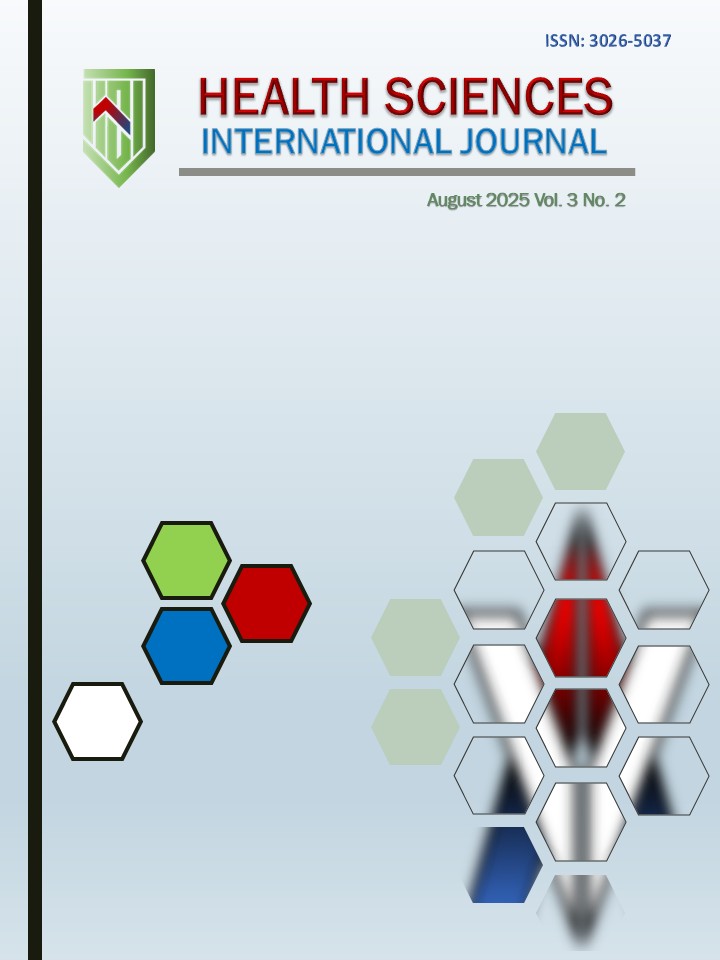Posyandu cadres roles and complete basic immunization coverage in Muara Teweh Community Health Center
DOI:
https://doi.org/10.71357/hsij.v3i2.77Keywords:
Posyandu cadres, Immunization coverage, Community health, Rural health volunteers, IndonesiaAbstract
Background: Complete basic immunization remains a critical public health intervention to reduce infant morbidity and mortality. In Indonesia, immunization coverage remains below the national target, especially in remote regions such as Muara Teweh, Central Kalimantan. Posyandu cadres—community health volunteers—are essential actors in promoting immunization at the grassroots level. However, the effectiveness of their roles has not been consistently evaluated.
Objective: This study aimed to assess the association between the roles of Posyandu cadres—both during Posyandu sessions and outside regular activities—and the achievement of complete basic immunization coverage in Muara Teweh Comuunity Health Center.
Method: A quantitative cross-sectional study was conducted involving 32 Posyandu cadres in Kelurahan Pangkuh Raya. Total sampling was applied. Data were collected using a structured, validated questionnaire assessing cadre roles and immunization status, verified through Posyandu and Mother and Child Health records. Data analysis involved Chi-Square and Fisher’s Exact tests, with significance set at p < 0.05.
Result: The findings revealed that 68.7% of infants had complete basic immunization. Most cadres (78.1%) were highly involved during Posyandu, and 87.5% were active outside it. However, statistical analysis showed no significant relationship between cadre roles during (p = 1.000) or outside (p = 0.465) Posyandu and immunization coverage.
Conclusion: While cadre involvement was generally high, it did not significantly impact immunization outcomes. Future interventions should focus on improving cadre communication skills, addressing contextual barriers, and integrating supportive systems to enhance immunization effectiveness in remote settings.
Downloads
References
Abubakar, B. D. (2024). Health workers perceived hindrances to implementation of national programme on immunization among people in Kwara State, Nigeria. Pan-African Journal of Health and Environmental Science, 3(1), 12–26. https://doi.org/10.56893/ajhes2024v03i01.02
Amir, A. N., Darwin, E., & Lestari, Y. (2018). Analysis factors related to implementation of complete basic immunization in work area of Pengambiran Public Health Center in Padang 2017. Journal of Midwifery, 3(1), 52. https://doi.org/10.25077/jom.1.1.52-61.2018
Renaldi, A., Katimenta, K. Y., & Wiyono, H. (2024). The relationship between knowledge and the role of Toddler Posyandu Cadres in achieving complete basic immunization in the working area of Bahaur Hilir Community Health Center, Pulang Pisau Regency [in Indonesia]. OBAT: Jurnal Riset Ilmu Farmasi Dan Kesehatan, 2(6), 80–94. https://doi.org/10.61132/obat.v2i6.799
Anil Batta. (2020). Herd immunity: In relation to COVID-19. World Journal of Biology Pharmacy and Health Sciences, 4(2), 049–055. https://doi.org/10.30574/wjbphs.2020.4.2.0093
Athiyaman, A., Ajayi, T., Mutuku, F., Luwaga, F., Bryer, S., Giwa, O., Mngemane, S., Edwige, N. N., & Berman, L. (2023). Recovering from the unprecedented backsliding in immunization coverage: learnings from country programming in five countries through the past two years of COVID-19 pandemic disruptions. Vaccines, 11(2), 375. https://doi.org/10.3390/vaccines11020375
Cardoso Pinto, A. M., Shariq, S., Ranasinghe, L., Sundar Budhathoki, S., Skirrow, H., Whittaker, E., & Seddon, J. A. (2023). Reasons for reductions in routine childhood immunisation uptake during the COVID-19 pandemic in low- and middle-income countries: A systematic review. PLOS Global Public Health, 3(1), e0001415. https://doi.org/10.1371/journal.pgph.0001415
Dewanti, D., Notoatmodjo, S., & Agustina, S. (2022). Completeness basic infants immunization to achieve universal child immunization at the Public Health Center Semparuk Sambas West Kalimantan In 2021. Journal of Ageing And Family, 2(1). https://doi.org/10.52643/joaf.v2i1.2168
E, B. I., E, B. E., Ibezim, H., I, E. C., E, O. T., E, A. D., Emina, A., V, N. A., P, O. C., V, I. E., & Malachy, O. (2025). Threats analysis and control strategies in immunization programs for rural communities in Nigeria. Global Academic Journal of Medical Sciences, 7(01), 13–26. https://doi.org/10.36348/gajms.2025.v07i01.003
Erynda, R. F., Sulaeman, E. S., & Pamungkasari, E. P. (2020). Contextual effect of the integrated health post and other determinants on completeness of basic child immunization: A multilevel analysis evidence from Jember, East Java. Journal of Maternal and Child Health, 5(2), 154–166. https://doi.org/10.26911/thejmch.2020.05.02.05
Essa-Hadad, J., Gorelik, Y., Vervoort, J., Jansen, D., & Edelstein, M. (2024). Understanding the health system barriers and enablers to childhood MMR and HPV vaccination among disadvantaged, minority or underserved populations in middle- and high-income countries: A systematic review. European Journal of Public Health, 34(2), 368–374. https://doi.org/10.1093/eurpub/ckad232
Health Agency of Central Kalimantan. (2020). Health profile of Central Kalimantan - 2020. Dinas Kesehatan Provinsi Kalimantan Tengah.
Herlianty, H., Sridahrianti, E., & Rasdin, R. (2023). Optimizing children’s health: The importance of immunization at Posyandu. Abdimas Polsaka, 2(2), 135–140. https://doi.org/10.35816/abdimaspolsaka.v2i2.54
Hindi Albalawi, H. M., & Rezq, K. A. (2024). Influences of cultural factors on vaccination practices among parents prior to school age: A systematic review and meta-analysis. Cureus. https://doi.org/10.7759/cureus.75845
Kowalzik, F., & Zepp, F. (2019). Risiko Impfen? DMW - Deutsche Medizinische Wochenschrift, 144(04), 254–261. https://doi.org/10.1055/a-0479-3756
Ministry of Health - Republic of Indonesia. (2022). National Communication Strategy - Immunization 2022-2025 [in Indonesia]. Direktorat Promosi Kesehatan dan Pemberdayaan Masyarakat Kementerian Kesehatan RI.
Muti, O., K. A Littik, S., . M., Trisno, I., & A. Nalle, A. (2020). Analysis of factors affecting the achievement of complete basicimmunization for babies in Weliman Public Health Center Malaka Regency. EAS Journal of Nursing and Midwifery, 2(6), 344–351. https://doi.org/10.36349/easjnm.2020.v02i06.003
Ofei-Dodoo, S., McGhie, R., McKaughan, K., Loo-Gross, C., Duncan, L., Regehr, J., & Martin, F. (2023). Factors influencing parental intent to vaccinate children against COVID-19 in the United States. COVID-19, 4732. https://doi.org/10.1370/afm.22.s1.4732
Rahmayanti, W., Fitriani, S., Hidayani, W. R., Yogaswara, D., Turiano, L., & Tagum, K. N. H. (2022). Factors related to the performance of cadres in the implementation of community based health service activities. Journal of Public Health Sciences, 1(02), 55–70. https://doi.org/10.56741/jphs.v1i02.82
Richard, O. (2024). Challenges of immunization in Africa: Overcoming barriers to achieve universal vaccination. Nursing & Primary Care, 8(4). https://doi.org/10.33425/2639-9474.1272
Mufida, R. T., Rohmah, M., & Pramita, D. (2024). Support from health workers for the participation of mothers and babies for immunization at Posyandu Tulif, Cempaga Hulu District, East Kotawaringin Regency. Journal of Health Science Community, 4(3), 149–156. https://doi.org/10.30994/jhsc.v4i3.209
Shrivastava, S., Shrivastava, P., & Ramasamy, J. (2014). Herd immunity: A realistic goal for elimination of communicable diseases. TAF Preventive Medicine Bulletin, 13(2), 187. https://doi.org/10.5455/pmb.1-1359091665
Siagian, L., & Hasibuan, R. (2024). Factors related to the activity of Posyandu Cadres in the immunization program of Sudirejo Village I. Journal of Health Sciences, 17(02), 176–183. https://doi.org/10.33086/jhs.v17i02.5098
Ulfah, N. H., Rachmawat, W. C., Rahmawati, I. T., Katmawanti, S., Samah, D. A., Wahyuni, O. S., Aulia, S. N., & Az Zahra, A. R. (2025). Public health implications of the relationship between socioeconomic and cultural dimensions on immunization coverage in Bangkalan, East Java. BIO Web of Conferences, 152, 01023. https://doi.org/10.1051/bioconf/202515201023
WHO. (2022). Indonesia's National Child Immunization Month has ended, but urgent efforts are still needed to address the setback in child vaccination – UNICEF & WHO [in Indonesia]. WHO. https://www.who.int/indonesia/id/news/detail/05-10-2022-as-indonesia-s-catch-up-immunization-campaign-ends-urgent-efforts-still-needed-to-address-backslide-in-childhood-vaccinations-unicef-who
Widarti, W., Rinawan, F. R., Susanti, A. I., & Fitri, H. N. (2019). Differences in knowledge of Posyandu Cadres before and after training on the use of the iPOSYANDU [in Indonesia]. Jurnal Pengabdian Dan Pengembangan Masyarakat, 1(2), 143. https://doi.org/10.22146/jp2m.43473
Soumokil, Y., Tukiman, S., & Makatita, H. (2023). The relationship between the role of cadres and the completeness of basic immunization in infants aged 9-12 months at the Posyandu in Wakasihu Village [in Indonesia]. Jurnal Ilmu Kesehatan Dan Gizi, 2(1), 94–106. https://doi.org/10.55606/jikg.v2i1.2109
Downloads
Published
Issue
Section
License
Copyright (c) 2025 Ayu Nathalia, Meldawati, Rabia Wahdah, Meldawati, Rabia Wahdah

This work is licensed under a Creative Commons Attribution-ShareAlike 4.0 International License.
Health Sciences International Journal (HSIJ) © 2023 by Ananda Health and Education Foundation is licensed under Attribution-ShareAlike 4.0 International







